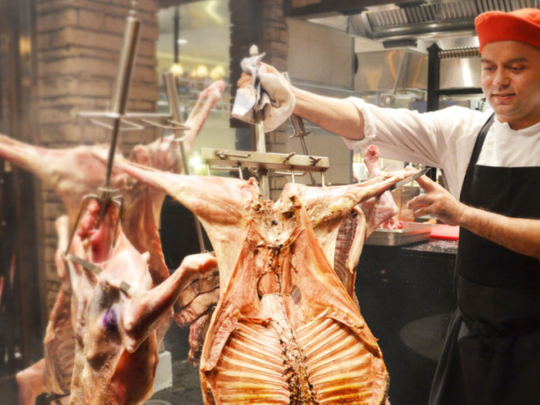
Rio Carnival, currently drawing millions to the streets each night, is the world’s biggest party. And although it may only last a week, Latin American food is here to stay.
The cuisine has been popping up on food-watcher’s trend lists for the past couple of years, and has today become ‘the’ cuisine to watch out for.
In forecasts for 2013, Latin American food popped up on trend food boards from the likes of ingredients firm Bell Flavors & Fragrances and food research firm Technomic. Here in the UAE, the year opened with a big Brazilian bang, with January welcoming two new restaurants specialising in food from the South American nation.
Fogo Vivo — the name means “living fire” in Portuguese — at the new Ocean View Hotel at the Jumeirah Beach Residence development offers 12 different cuts of fire-roasted meats, served by experienced Gauchos. Diners get to sample the meats that are brought to the table on large skewers and carved onto the plate.
Frevo at Fairmont, The Palm, is being pegged as the city’s only authentic Brazilian churrascaria experience and is billed as a great place to dine with family and friends in the mood for fun and flavourful food. Succulent cuts of meat are all served in espeto (skewer) corridor-style, originating from south Brazil where skewers of lamb, beef and chicken are carved at the table.
They join a host of city restaurants specialising in South American fare. From one notable restaurant — Pachanga at the Hilton Jumeirah, which serves ceviche salad from Peru, meat from Brazil, seafood from Chile, corn cakes from Venezuela and empanadas from Argentina — the city is now home to no less than 20 Latin American eateries. Hotels unable to open a restaurant dedicated to Latin American food simply lay on special theme nights. One of these is the Al Bustan Rotana’s Choices Restaurant, whose Latina Cucina Night aims to recreate the passionate Latino lifestyle with delicious food and lively music.
“When you say Latin, the first adjectives that come to diners’ minds are fun, colourful and flavourful. Diners love these, hence Latin is such a big hit in the industry right now,” says Alban Daubenton, Rotana’s Director of Food and Beverage.
The Mexican celebrity chef Richard Sandoval runs two LatAm restaurants, Toro Toro at the Grosvenor House and Maya at Le Royal Meridien Beach Resort. He believes the cuisine group is a natural fit for the UAE. “It is bold, full of unique, vibrant flavours and reflects the merging of many cultures,” he tells GN Focus. “For instance, Peruvian cuisine famously uses Japanese techniques, as a result of Japanese immigrants settling there after Second World War. Brazilian cuisine incorporates ingredients and techniques carried over from Africa, and so on,” says Sandoval.
Fernando Lima, Frevo’s Chef de Cuisine, agrees. “Latin American cuisine has been popular in Dubai for some time now with a good line-up of restaurants, but in a city that celebrates steakhouse cuisine, Latin American fits this profile. Moreover, this scene is picking up momentum as it is all about gatherings of people and celebrations, just as you would find back in Latin America where dining is not only a family, but a community affair,” he says.
And the cuisine’s serving traditions seem almost designed for the contemporary trend of viewing eating out as an entertainment option. “Distinct flavour profiles influenced by indigenous spices and foods, including pico de gallo, mole, chimichurri, and pebre, as well as serving style, such as the churrasco style, as found in our newly debuted Brazilian restaurant Frevo, really add to the vibrant ambience and a full sensory experience,” says Lima.
Although some may resist a broad “Latin American” grouping, Sandoval says most countries in Latin America work with the same strong staples: chillies, corn, rice and beans. These are then prepared differently and used as accompaniments to meats or fish.
Matias Ayala, Chef de Cuisine at Pachanga, says cooking styles across the region are also similar. “Latin-American specialities vary from one country to another, but one thing that can be found across the regions is the asado or barbecue. Beef or chicken meats, marinated in different types of sauces, among the best known is chimichurri, based on parsley, garlic oregano and olive oil. Meats are grilled, served simple or with sauce,” he says.
Martin Sosa, a Dubai resident from Buenos Aires, says meat is central to Latin American food, particularly Argentinian. “We love our meat. It is always about the meat, from the way it is cooked to which side of the cow it comes from. We also believe in keeping it simple — meat should taste like meat. It is cooked only with salt to open up the veins,” he says.
Further north, in Brazil, meat is often cooked with beans, says Vanessa Franulovic, an expat from Sao Paulo. “You won’t find a typical Brazilian meal without rice and beans and meat,” she says. “Some of the everyday home cooked favourites include feijoada, a dish with black beans and meat that is simply flavoured with garlic and onions and eaten with spicy peppers, couve and oranges. Oranges are served with certain meats as people believe that the fruit helps in cutting down fat.”
With barbecued meat, roasted vegetables and plenty of salads, there are surprising similarities between Arabian and Latin American food. For one, both these food cultures prefer to grill the meats with minimum fuss. You won’t find pungent marinades, but an almost zen-like approach to letting the meat speak for itself, although it is served with sauces for every palate.
While those familiar with Bedouin cooking will happily narrate tales of tucking into whole roast camel, a similar delicacy from Argentina has found favour with Dubai diners. The signature dish at Asado, the Argentinean restaurant at The Palace Downtown Dubai, is the cabrito: a baby goat cooked in an asador criollo or open-fire charcoal pit in the middle of the restaurant. The cabrito is cooked for about four hours in chimichurri sauce, resulting in succulent meat that is crisp on the outside and tender on the inside.
In other words, it’s like a party in your mouth.








